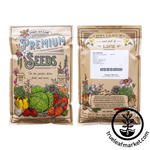
- Borage can be grown as an indoor or outdoor herb, is known to produce some of the most fragrant and delicious edible flowers, and has a cucumber-like taste.
60-70 Days. Borage Culinary Herb Seeds. Borago officinalis. Non-GMO. Heirloom. Borage seeds are grown as both an indoor culinary herb and an open-pollinated garden herb. Non-GMO Borage seeds produce some of the most fragrant and delicious edible culinary flowers loaded the Omega-6 fatty acid GLA. With a cucumber-like taste, Borage herb flowers make an easy summer treat for teas, salads, and dried herbal blends. Try as a heat tolerant companion plant for natural pest control. ~1,500 seeds/oz.











